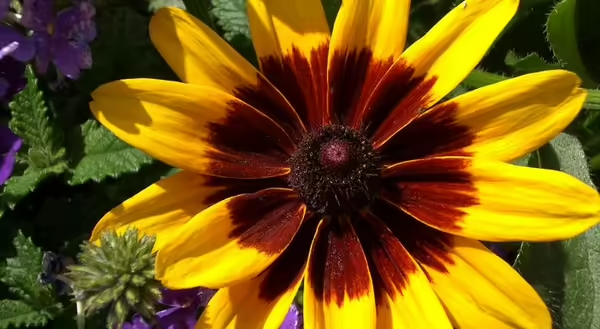
Supporting pollinators has become increasingly important as concerns over pollinator population decline are more evident. The good news is that even small spaces can provide resources for bees, butterflies, and other pollinators.
Container gardens are one solution for growing pollen and nectar resources that pollinators need in small spaces. Containers offer many options, from simple, single-plant systems to multi-level and extended blooming displays.
For those who like to keep things simple, stick to shorter plants that will not get top-heavy or wilt at the first sign of drought. Both usually happen to container gardens at some point throughout the growing season because container soil tends to dry out quickly.
Sample Container Combinations
For a combination of plants that will bloom at different times in a partial to full-sun location, try penstemon (sp.), lanceleaf coreopsis, wild geranium, Agastache anise, and silverrod (Solidago bicolor).
A mix of prairie dock (Silphium terebinthinaceum), rose turtlehead (Chelone obliqua), purple lovegrass (Eragrostis spectabilis), sky blue aster (Symphyotrichum oolentangiense), and prairie dropseed (Sporobolus heterolepis) is another mixed container that will love a full-sun area.
For areas with more shade, try blue mistflower (Conoclinium coelestinum), cinnamon fern (Osmundastrum cinnamomeum), Gray’s sedge (Carex grayi), little alumroot (Heuchera pariflora var. puberula), common dittany (Cunila origanoides), Pennsylvania sedge (Carex pensylvanica) to make a lovely container. Foam flower (Tiarella cordifolia), native to the eastern U.S., can also be added to the container.
Adding Native Plants
When choosing native plants for containers or a landscape, growers will likely find that regional native plants are best suited for the site. Remember that some smaller nativars will likely be better suited to a container.
Try to choose nativars with flowers and leaves that are as close to the native species as possible so that the pollinators can access the nectar and pollen resources. In general, nativars that reduce the height of the plant are visited by pollinators in similar numbers to the open-pollinated plants.
When planting perennials, not annuals with constant bloom, consider planting several different species with different bloom times. Including plants with interesting foliage gives the container visual interest for a long season. Native annuals can also be added for color throughout the season.
Tips for Choosing Containers
Make sure the container size fits the plants. Be sure that the container will fit the plants at their mature sizes, not the 4″ pot or plug size. The container should be fairly large if growing multiple species in one container.
Plants in containers dry out much faster than plants in a landscape, so stay on top of the watering. Consider the ideal conditions for the plants, including pH, soil drainage, full sun vs. shade, and moist soil vs. dry soil. Use plants that tolerate the same conditions in the same pot.
Using frost-proof containers and mulch around the pots over winter can keep native plants in containers year-round, even in colder climates. Keep the soil biology going by adding compost and leaves.
Make sure to leave the potted plants standing through the winter to provide seed for birds and as a habitat for overwintering insects. Cut them back in early spring.
Everyone should feel encouraged to try out different plants if they like them. Sit back and enjoy the butterflies, bees, beneficial insects, and birds attracted by planting great native plants in containers.
For more options for selecting plants for Illinois pollinators, visit pollinators.illinois.edu.
MEET THE AUTHOR
Nicole Flowers-Kimmerle is a Agriculture and Natural Resources (Horticulture) Educator for Fulton, Mason, Peoria and Tazewell counties. She completed a bachelors of science degree in crop science at the University of Illinois, and a master’s of science degree in agronomy with an emphasis in weed science at the University of Wisconsin-Madison. She has also worked at Montana State University as a research associate where she worked on weed control in sugar beets and barley. She taught high school chemistry and other science classes where she was able to teach students in both the school garden and greenhouse. She works with both the Extension Master Gardeners and Extension Master Naturalists.
ABOUT THE BLOG
ILRiverHort is a blog that helps people connect to nature and grow.
Image by Judy Richardson from Pixabay